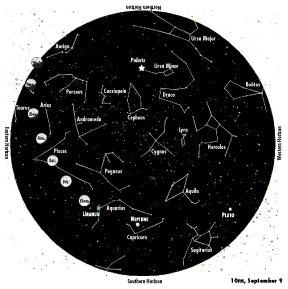 |
Sky Watch
by J. Alex Knoll
|
A Marvelous Night for a Moon Dance
Harvest Moon reveals moon’s surface
September’s full Harvest Moon brightens our night Thursday like a celestial beacon, rising in the east at sunset and following a lazy, low arc across southern skies before setting in the west at sunrise. Few farmers rely on the added light of this moon to bring in their crops, what with mechanization and multi-million dollar tractors with headlights. But time was that this night and the couple before and after September’s full moon could make the difference between a bountiful harvest and crops dying on the vine or withered in the first early frost.
Traveling relatively close to the horizon, this moon appears exceptionally large, a trick of the eye caused by the moon’s visual proximity to objects here on earth, like trees or buildings. The Harvest Moon often takes on an orange or red hue, caused by diffusion of the moonlight as it passes through our atmosphere, much as a prism separates different colored light rays.
A look at the moon’s surface reveals two contrasting areas of light and dark, which were once believed to be land and sea, or maria. Seas they may have been, billions of years ago, as lava pulsed from the moon’s center and flooded these plains, leaving behind a dark, smooth-looking surface. The light-colored areas of the moon are the result of meteorites raining down and cratering the surface over the aeons since the moon’s earliest days.
Although craters and maria are equally distributed on the visible side of the moon, orbiting astronauts discovered that the dark side of the moon was practically devoid of maria. Astronomers now believe that the dark side of the moon’s crust is much thicker and thus prevented lava from reaching the surface.